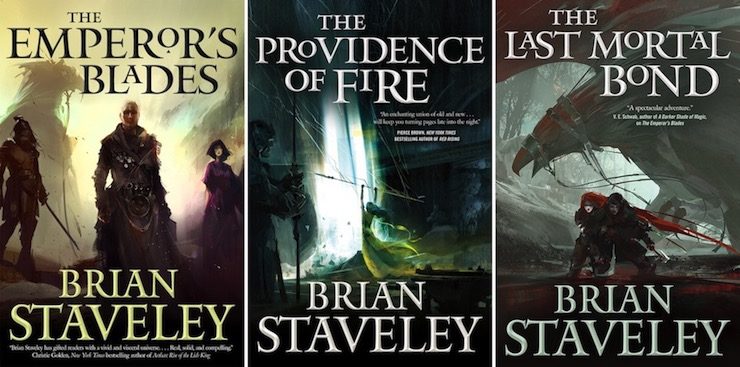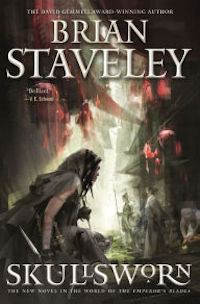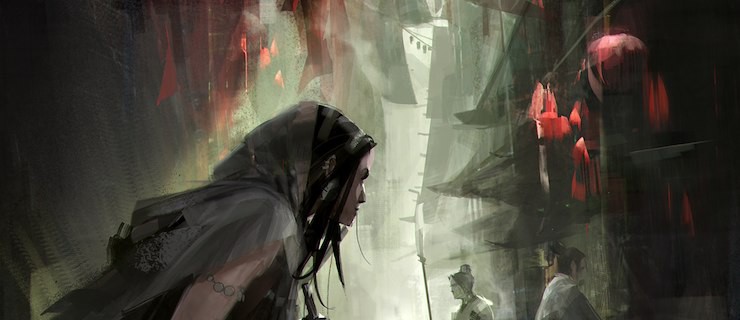Springing onto the epic fantasy scene a few years ago with his debut novel, The Emperor’s Blades, Brian Staveley was clearly a writer of immense potential energy. His debut, the first in a trilogy, promised a family steeped in tragedy and power, facing hard choices while occupying a world of deep lore, chaotic forces, and endless mystery. And as the children of the Annurian Empire grew, so too did Staveley’s mastery and range in the telling of their story.
From The Chronicle of the Unhewn Throne, and through his newest novel Skullsworn, Staveley has continued to not only level up on a nuts-and-bolts level, but to push himself as a writer, delving further into those corners of the world where he finds himself unsure, and balancing along that narrative knife’s edge, pushes on and breaks into brighter worlds. Staveley not only has injected a major breath of fresh air into the epic fantasy genre, he has done so to the benefit of his writing, as each new book sees him getting better, taking more risks, and daring to tell stories from new perspectives.
What caught my eye in The Emperor’s Blades was the intense focus on philosophy, on the spirit and reasons behind why we do things, and what we ultimately gain by our actions; on the intense push and pull between what our heart tells us and what our brain needs us to believe. We got to know Valyn through his Kettral training—the Kettral are the black ops division of the Annurian Empire, replete with magic users known as leaches, plus explosives, knives, preternatural abilities gained by ingesting prehistoric reptile eggs, and of course, the giant, black birds after whom the force is named: the Kettral. We meet Adare, the oldest child and the only daughter of the Emperor Sanlitun Hui’Malkeenian, still reeling in the aftermath of his death and the only royal sibling still at work in the capital. Adare finds herself suddenly besieged by forces looking to control her, even as she works desperately to prove herself and uncover her father’s killer. And then there’s Kaden, the youngest but the one being groomed for the throne due to tradition and a quirk of genetics. Kaden has been sent to apprentice with the Shin monks in their mountain monastery, seeking discipline and something known as the vaniate—an empty trance, devoid of emotion, that the monks continually strive to master. As the siblings come to terms with the death of their father, and what that means for each of them, an ancient conspiracy slowly reveals itself in the Csestriim, immortal, emotionless beings who once tried to kill off humanity, and it seems are back to finish the job after countless millennia.
While there is plenty original in the above, it’s the attention that Staveley pays to the particulars in each that truly pay off; his concern with language, philosophy, the minute turnings of characters and their choices, and how those ripples affect players continents away. His intricate plot turnings are only so strong, because he has spent so much time placing us in the minds and hearts of his characters. Kaden is fascinating to us because he must rid himself of emotion, though they are the very heart of him. Valyn intrigues us because for all his hope for joy, he is a killing machine, and must remain so in order to stay alive. Adare draws our eye because for all her strength and savvy, she is barely a step ahead, and has to make decisions without all the information. The arcs Staveley constructs for these siblings in the first book alone are strong, especially for a debut. But the interesting thing is, that when it came to the criticisms people had for the first book, Staveley didn’t ignore these points, or brush them under the rug: he embraced them, and tackled them head on in the sequel, Providence of Fire.

Some readers definitely had issues with Adare in The Emperor’s Blades, saying that she was more a vehicle for the story or that she wasn’t served as well as her brothers. Even though, as we learned later, he’d always planned for Adare to play a bigger role in the coming books, Staveley still took that criticism to heart and flexed his authorial muscles, giving Adare a deeper, more complicated, and better served story in the sequel, and even into The Last Mortal Bond. He worked to deepen her character, to bring us further into her confidence, to get to know the true heart of her. Likewise, the murder of Valyn’s love interest Ha Lin seemed to be a well-worn trope of a woman dying at a villain’s hand in order to motivate the love interest. But again, Staveley listened to his readers and critics, and not only did Adare come into much sharper focus in book two, but other woman in his world—Gwenna, Annick, Triste—grew even further into deep, three-dimensional characters who were not beholden to the story of the men around them, but rather had their own agency on full display. Staveley as a writer is so good because he grows and changes, and continually pushes himself.
And even more, all throughout Providence of Fire, Staveley continues to put pressure on and push on the deepest questions ingrained into the hearts of our characters. What is the point in fighting evil if you become evil in the process? Are we human because of our emotions, and what do we become when we are emptied of feeling and passion? Is pain a tool to be used to open oneself to the world, or is it a weapon to cut down those who would oppose us? How much do we owe family, especially when the cost of trust could be lives in the balance? Do our gods serve us, or do we serve them? Staveley is unafraid to pursue these enormous, philosophical questions, especially as he answers them through action, not just dialogue or pontification. Things get even more complicated with the introduction of Csestriim characters, beings who have been alive for centuries, and who live with completely alien viewpoints, who cannot seem to comprehend mortality’s demands or visions. Watching these two branches of sentience interact lead to some of the most interesting moments of the series. And that’s to say nothing of the gods that are called into action, called by the demand of humanity, and the plots of the Csestriim.
But it’s in The Last Mortal Bond that everything comes to a head. Staveley’s voice in the final book of this trilogy is confident, methodical, decisive, and strong, as everything he’s been tackling comes to a head, as gods and man work to outrace the Csestriim, and survive long enough to figure out how to get the gods home safely: for if they’re killed on the mortal plane, their influence dies with them, ridding the world of their aspect. And here Staveley dives deep into the worlds of both love and pain, as Kaden and Triste host the two deities, and work to keep them alive from Csestriim predations. These themes echo along with Valyn, blinded, broken, but more than human, and seeking vengeance, and Adare, the sister who hurt him, thinking she was doing the right thing, and working to reclaim her empire, wresting it away from the Csestriim holding it captive. Staveley’s voice swings through beat after beat, forcing characters to reckon with those they love, those they hate, those they fear, and the pain they all have passed among themselves in the pursuit of ending this conflict. From The Emperor’s Blades, Staveley’s voice evolved quickly, but not without effort. The confidence and drive on display in full, as he maintains complete control of the story, making it look easy. And the ending is worth the wait, as it moved me to tears, to see what comes of the Malkeenian siblings, and the defense of humanity and emotion in the face of potential genocide.
 Even now, Staveley continues to impress with his latest standalone novel, Skullsworn, which follows the Pyrre Lakatur, in her younger days as she trains to become the inimitable priestess of death we meet in the Chronicle of the Unhewn Thrown books. For readers new to Staveley’s fiction, the novel is just as strong a starting point in Staveley’s universe as the earlier books (though of course you will get more context from reading the trilogy first). Skullsworn introduces us to a younger, less perfect Pyrre, as well as her two teachers; the stony, grumpy old assassin-priest Kossal, and his effervescent, deadly partner, Ela. The author’s voice is confident as ever, but ever evolving—this novel is written in first person, and also from the perspective of someone who does not view death with disdain or fear, but reverence and awe: a killing machine who needs to fall in love in order to serve her god, Ananshael. The pursuit of philosophy is expertly balanced in the pursuit of plot, and as long as Staveley continues to work compelling magic between these two deep subjects while bringing us to new and strange places in his world, he’ll always have a reader in me.
Even now, Staveley continues to impress with his latest standalone novel, Skullsworn, which follows the Pyrre Lakatur, in her younger days as she trains to become the inimitable priestess of death we meet in the Chronicle of the Unhewn Thrown books. For readers new to Staveley’s fiction, the novel is just as strong a starting point in Staveley’s universe as the earlier books (though of course you will get more context from reading the trilogy first). Skullsworn introduces us to a younger, less perfect Pyrre, as well as her two teachers; the stony, grumpy old assassin-priest Kossal, and his effervescent, deadly partner, Ela. The author’s voice is confident as ever, but ever evolving—this novel is written in first person, and also from the perspective of someone who does not view death with disdain or fear, but reverence and awe: a killing machine who needs to fall in love in order to serve her god, Ananshael. The pursuit of philosophy is expertly balanced in the pursuit of plot, and as long as Staveley continues to work compelling magic between these two deep subjects while bringing us to new and strange places in his world, he’ll always have a reader in me.
Chronicle of the Unhewn Throne—The Emperor’s Blades, The Providence of Fire, and The Last Mortal Bond—is available as an ebook omnibus.
Skullsworn is also available now from Tor Books. You can read an extended excerpt from the novel, starting here.
Martin Cahill is a contributor to Tor.com, as well as Book Riot and Strange Horizons. He has fiction forthcoming at Beneath Ceaseless Skies and Fireside Fiction. You can follow his musings on Twitter @McflyCahill90.










